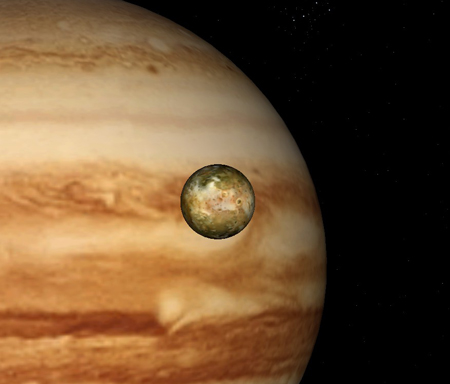Life can exist on Jupiter satellites
The underground ocean on a Jupiter satellite may contain enough oxygen to support living activity.
In the past few decades, mankind has not found any convincing evidence that life exists outside the earth, but scientists have long considered Europa - celestial bodies flying around Jupiter - the ideal place. to search for biological activity.
Europa is the sixth satellite, orbiting from inside to outside, Jupiter. The young and very smooth surface of Europa makes scientists believe there is an underground ocean beneath its outer layer.
The Europa on the ocean lies below a few kilometers of ice, so scientists are not sure if it has much oxygen. It is thought that oxygen is created on the surface of the ocean by the process of interaction between water and particles carrying charges from the sun. Scientists always agree that oxygen is essential for the metabolism of living organisms. Oxygen is only unnecessary for organisms that are capable of using toxic chemicals such as methane (CH4) or sulfur.

Satellite Europa (smaller) and Jupiter Photo: free-review.net.
According to Space, the amount of water in the ocean on Europa is about twice that of all the oceans on earth. So the amount of oxygen on it could be hundreds of times greater than the scientific prediction.
To determine the amount of oxygen in the underground ocean of Europa, Richard Greenberg - a University of Arizona scientist (USA) decided to study that celestial surface. Using computer models to calculate the rate of oxygen generation on the surface of the underground ocean, he found that the speed of oxygen transport in the ocean was so great that the oxygen concentration in the water could exceed the ocean of the left. land for several million years.
Greenberg said that the oxygen could be large enough to support the biological activity of microorganisms, even large animals.
Of Jupiter's four major satellites discovered in 1610, Europa is the smallest. It has a diameter of 3,100 kilometers, a little smaller than the Moon. In the Solar System, Europa is the sixth largest satellite. This body is made up primarily of silicate rock and may contain iron cores. The surface of Europa is made up of recent geological tectonics, with many cracks and rock seams but very few craters.
- Raw materials of life exist on Jupiter satellites
- What happens if Jupiter doesn't exist?
- NASA's concussion detection: There is life on Jupiter's satellite
- NASA: Will find alien life in the next 10 years
- Discover 10 more microscopic satellites orbiting Jupiter
- The ocean is located very deep on Jupiter's satellite
- Aliens follow the spacecraft to Earth?
- Detecting traces of alien life
- Overview of Jupiter
- The fountain of 200,000m high on Jupiter's Moon
- NASA holds press conference to announce: Is there life on Jupiter's Moon Europa?
- NASA is about to announce a new discovery about Jupiter moon tonight
 10 famous Isaac Newton inventions
10 famous Isaac Newton inventions 'Doomsday 2021' and Mayan conspiracy theories
'Doomsday 2021' and Mayan conspiracy theories 7 perspective of the destruction of the Earth
7 perspective of the destruction of the Earth Isaac Newton predicted the world would end in 2060
Isaac Newton predicted the world would end in 2060 Scientists say textbooks teach wrong about the origin of life on Earth
Scientists say textbooks teach wrong about the origin of life on Earth  New idea allows researchers to make oxygen on Mars
New idea allows researchers to make oxygen on Mars  Scary things that happen to the human body in the 'death zone' of Mount Everest
Scary things that happen to the human body in the 'death zone' of Mount Everest  Scientists discover new type of oxygen with strange properties
Scientists discover new type of oxygen with strange properties  Explore the highest inhabited place on Earth
Explore the highest inhabited place on Earth  Invention of oxygen batteries that can be permanently implanted in the body
Invention of oxygen batteries that can be permanently implanted in the body 